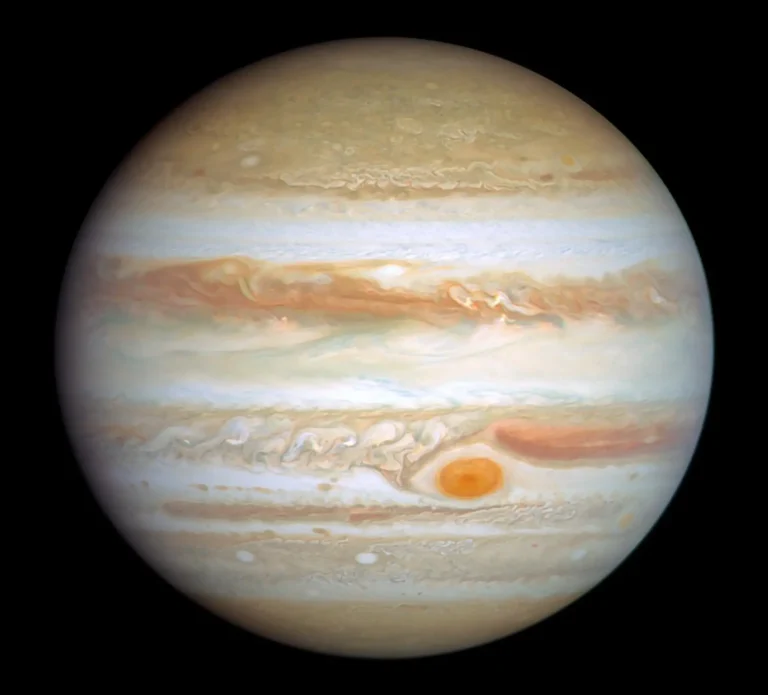Great Red Spot of Jupiter: A Cosmic Storm Like No Other
The Great Red Spot of Jupiter is one of the most fascinating features in our solar system. This massive, swirling storm has captivated astronomers and space enthusiasts for centuries. But what exactly is it, and why is it so important?
In this article, we’ll explore the origins, size, color, and mysteries of the Great Red Spot — and answer the most frequently asked questions about this iconic Jovian storm.

What is the Great Red Spot?
The Great Red Spot is a gigantic storm located in the southern hemisphere of Jupiter. It’s often described as a “super hurricane”, except it’s far more powerful and has lasted much longer than any storm on Earth.
Scientists believe it’s been raging for at least 350 years, possibly even longer. First observed through telescopes in the 1600s, the storm is made up of high-pressure winds moving in a counter-clockwise direction.
How Big is the Great Red Spot?
This storm is enormous — so big that Earth could fit inside it!
- Width: Around 10,000 miles (16,000 kilometers) as of recent measurements.
- Comparison: That’s roughly 1.3 times the diameter of Earth.
- Note: It’s actually shrinking over time, though scientists aren’t exactly sure why.
Why is it Red?
One of the biggest mysteries is its striking reddish-orange color. Scientists haven’t confirmed the exact cause, but here are a few theories:
- Chemical Reactions: Sunlight might be reacting with compounds like ammonia and acetylene in Jupiter’s atmosphere.
- Altitude: The storm sits higher in the atmosphere, possibly exposing different chemicals to solar radiation.
The color can also change slightly over time, ranging from deep red to pale salmon pink.
What Causes the Storm?
The Great Red Spot isn’t just a random weather event — it’s a massive, high-pressure storm that’s been churning in Jupiter’s atmosphere for centuries. Understanding what causes and sustains it reveals a lot about how weather works on gas giants like Jupiter.
A Giant Anticyclone
At its core, the Great Red Spot is an anticyclone — a type of storm where winds spiral outward from the center in a counter-clockwise direction in Jupiter’s southern hemisphere. Unlike low-pressure systems (like hurricanes on Earth), anticyclones involve high pressure at the center and create a more stable and long-lasting system.
Powered by Jupiter’s Internal Heat
One of the key drivers behind this storm is Jupiter’s internal heat. Unlike Earth, which relies heavily on the Sun for its weather, Jupiter radiates more heat than it receives from the Sun.
This internal energy stirs the planet’s thick atmosphere, creating powerful jet streams and turbulence — perfect conditions for spawning massive storms like the Great Red Spot.
No Solid Surface = Longer Lifespan
On Earth, storms lose energy as they pass over land or cool oceans. But Jupiter doesn’t have a solid surface — it’s a ball of gas with deep atmospheric layers. This means storms like the Great Red Spot have no friction or land barriers to slow them down, allowing them to persist for centuries.
Atmospheric Composition Plays a Role
Jupiter’s atmosphere is made up of hydrogen, helium, ammonia, methane, and other gases. The way these elements interact under pressure and heat adds to the storm’s unique behavior. The different chemical reactions at various altitudes also help maintain the storm’s layered structure.
Can We See Great Red Spot from Earth?
Yes, you can! With a moderate telescope, amateur astronomers can spot the Great Red Spot from Earth — especially when it’s facing our planet during Jupiter’s rotation (which takes about 10 hours).
Has Any Spacecraft Visited the Great Red Spot?
Several NASA missions have studied Jupiter and its storm:
- Voyager 1 and 2 (1979): Captured detailed images.
- Galileo (1995–2003): Provided insights into Jupiter’s atmosphere.
- Juno (2016–present): Continues to give us close-up, high-resolution images and data of the Great Red Spot.
FAQs About the Great Red Spot
Is the Great Red Spot shrinking?
Yes, it is. Since the 1800s, it has reduced to about half its original size. Scientists are still studying why this is happening.
How long will the Great Red Spot last?
No one knows for sure. Some models predict it could vanish in a few decades, while others suggest it may persist for centuries.
How fast are the winds in the storm?
Winds can reach speeds of over 430 km/h (270 mph) — much faster than any hurricane on Earth.
Is the Great Red Spot dangerous?
Not to us! It’s located over 400 million miles away. But it would be extremely violent and destructive if something were caught in it.
Does any other planet have a similar storm?
Yes, Neptune and Saturn also have large storms, but none are as famous or long-lasting as Jupiter’s Great Red Spot.
Why is the Great Red Spot Important?
Studying the Great Red Spot helps scientists understand:
- How planetary weather systems work.
- The dynamics of gas giants.
- Climate patterns in extreme environments.
It also sparks curiosity and reminds us of how vast and mysterious our solar system truly is.
Final Thoughts
The Great Red Spot is more than just a big storm — it’s a symbol of Jupiter’s power and a window into the science of planetary atmospheres. As NASA’s Juno mission continues to explore Jupiter, we’ll hopefully uncover more secrets about this ever-changing cosmic wonder.
Read Similar Articles


